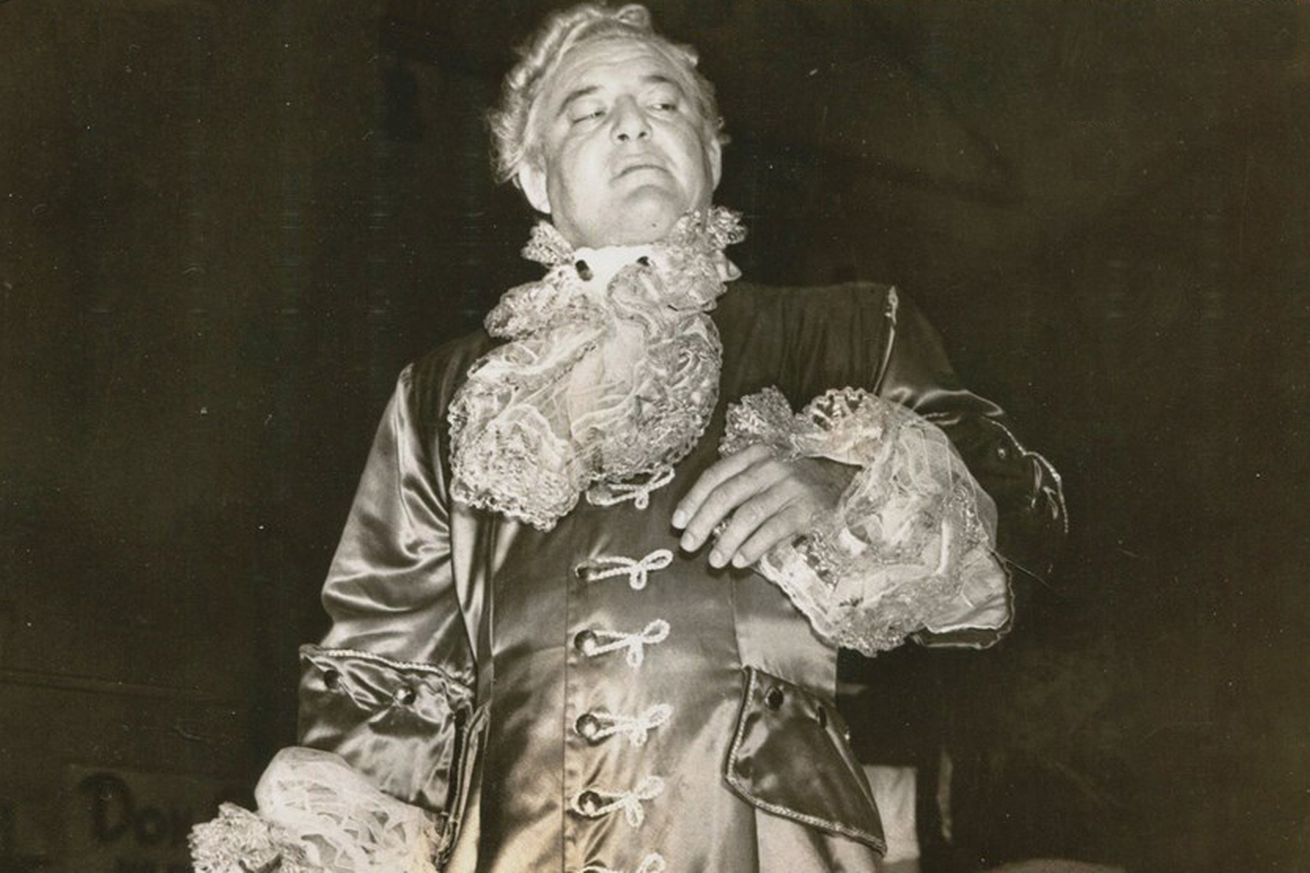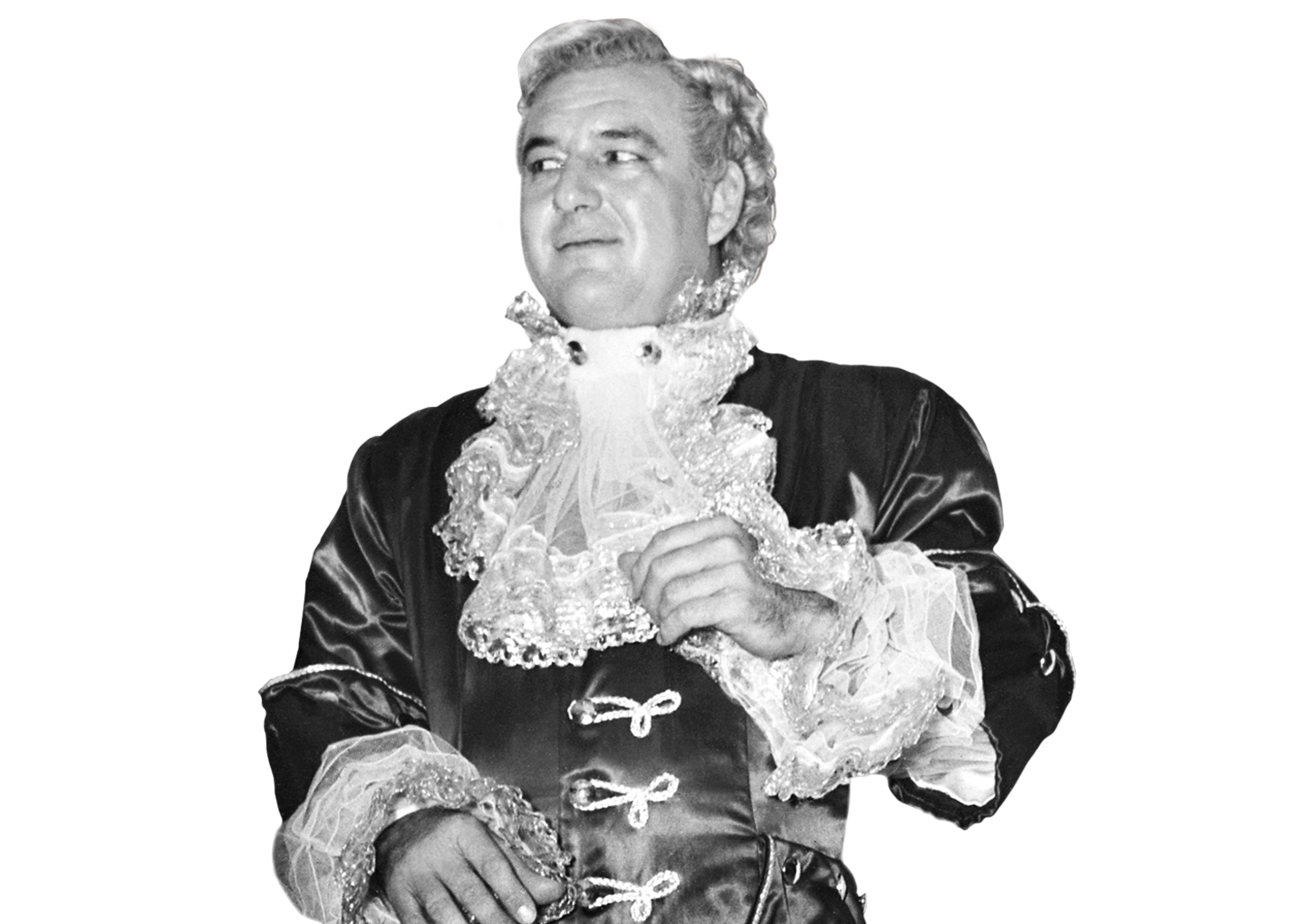When we think about professional wrestlers, we picture a myriad of colorful characters that spring to mind. Hulk Hogan, Randy Savage, The Undertaker, Andre the Giant, and a slew of others all captured our imaginations with the vibrant, larger-than-life characters they portrayed.
However, professional wrestlers weren’t always like this. Had you asked somebody a century ago to describe a professional wrestler, it is unlikely they’d be describing a character to you at all. That’s not because Kayfabe didn’t exist. It was in its infancy in the 1920s, but because the pro wrestling gimmick as we understand it hadn’t been invented yet.

Gorgeous George and The Birth of the Modern Gimmick
Sure, there were wrestlers who had something we might recognize as a character, but they were very one-dimensional. Broadly speaking, gimmicks fell into two categories: Occupations and Foreigners. “Farmer” Martin Burns and Dr. Ben Roller are examples of the former, along with countless wrestlers who professed to have been lumberjacks.
Usually, the profession was one that suggested either a great deal of strength or an acute knowledge of the human body. Of the latter, we saw the likes of “The Terrible Turk” Yusuf Ismail and “The Russian Lion” George Hackenschmidt. However, for the most part, a professional wrestler was just that; a person who made a living by wrestling. That all changed thanks to a man called George Wagner.
George Raymond Wagner was born in Butte, Nebraska in 1915. In his early years, his family moved to Iowa, the home state of then-recently retired Frank Gotch. In the wake of Iowa native Gotch’s 1908 World Heavyweight Championship victory over George Hackenshmidt and 1913 retirement, the Midwest saw something of a miniature wrestling boom as many Iowans sought to become a champion themselves.
Needless to say, the young George became fascinated with the sport. When he was 7, his family finally settled in Houston, Texas. While living in Houston, Wagner trained in weightlifting and amateur wrestling at his local YMCA. He dropped out of high school at 14 and began taking on odd jobs to help his family weather the Great Depression.
This is when he began competing at carnivals, earning 35 cents (about $6.15) every time he won. In 1932, at age 17, he came to the attention of Houston-area wrestling promoter Morris Siegel, who offered a chance for the young amateur wrestler to turn pro. Wagner eagerly accepted the offer and became a regular in the Texas wrestling circuit.

“Isn’t He Gorgeous?”
Billed at 5’9″ and weighing around 215 pounds, George Wagner didn’t exactly cut an imposing figure amongst wrestlers of his time. He was a solid mat wrestler, but in the mid-late 1930s, that wasn’t enough to take a smaller guy to the top of the card.
In 1937, George met Betty Hanson and embarked on a whirlwind romance before tying the knot in an in-ring ceremony in 1938. The wrestling wedding was not unheard of at the time, and the Wagners’ wedding drew a decent crowd. George and Betty realized that they could make a fair deal of money re-creating their in-ring ceremony around the country.
Their touring wedding took them to the Pacific Northwest, where George would have a series of short-lived light heavyweight championship reigns. People started to lose interest once the newlywed angle reached its conclusion, and he captured the championship. However, the experience gave him an insight into the untapped entertainment potential in professional wrestling.
Always Gorgeous
In 1939, Wagner learned of Ohio wrestler Wilber Finran, a similarly small wrestler who turned his struggling career around by adopting the persona of snobbish Irish noble ‘Lord’ Patrick Lansdowne. As ‘Lord’ Patrick Lansdowne, Finran would come to the ring in a velvet robe and doublet, flanked by not one but two valets.
Lansdowne’s in-ring tactics focused more on stalling and cheating than technical skill. George liked the idea of playing a snooty heel, but knew that he couldn’t just lift the character verbatim. Along with his then-wife Betty Hanson, he would begin to construct a brand new character who would take all of Lansdowne’s characteristics to the next level.
It started with a gown of his own, sewn by Betty, which he would neatly fold in the ring. As he chewed time folding his gown, he saw how antsy the crowd became and decided to take even longer. “The booing was tremendous,” said Oregon wrestling promoter Don Owen.
“The next week, there was a real big crowd, and everyone booed George. So he just took more time to fold his robe. He did everything to antagonize the fans.
And from that point on, he became the best drawing card we ever had around here. In wrestling, they either come to like you or to hate you. And they hated George.”
After that, George kept upping the ante. First, the design of his gowns became more and more detailed, including sequins, lace, and fur. Next, he started to grow his hair long, letting the waves in his hair show. Then he took it a step further, bleaching his naturally brown hair peroxide blond.
Each new addition to the character was designed to be more and more feminine, and, most importantly, outrageous. The final piece of the puzzle came to him while he was fussing with his robes in Eugene, Oregon in 1941. That night, he overheard a woman in the audience remark, “Isn’t he gorgeous?” and shortly afterwords, Gorgeous George took flight.

The First Golden Age
It may seem basic by today’s standards, but such showmanship was practically unheard of in professional wrestling in the 40s. Shortly after Gorgeous George’s 1941 debut in Oregon, Los Angeles promoter Johnny Doyle reached out to recruit him.
Working in LA meant working bigger crowds, which meant more money, and George put almost every penny of it into widening the scope of his character. He started wearing gold-plated bobby pins (which he called Georgie Pins) in his hair and distributed them to often ungrateful fans.
His entrances became more and more elaborate, incorporating multiple valets who would roll out a red carpet and “sterilize” the ring with bottles of “Chanel #10” (“why be half safe?” as George said).
He practically invented the modern pro wrestling entrance, as the lights would dim, Pomp and Circumstance would play, and George would make his way to the ring under a lavender spotlight. All this in a time where entering to music was only done by NWA World Women’s Wrestling Champion Mildred Burke.
The Gorgeous To The Core
And that’s where we get to the core of the Gorgeous George character. Sure, his cheating was a strong reason for audiences to dislike him, but the reason they disliked him so strongly is that, on top of all the cheating, he was effeminate. To straight-laced, postwar America, a man acting effeminately read as gay.
While George was ratcheting up his outrageous character, something else was happening in America: The Television was becoming a common household item. In a time with relatively little original content, Gorgeous George was a spectacle all on his own. George Wagner’s antics as Gorgeous George kicked off the first golden age of pro wrestling in the 1950s and as he traveled between territories, he would become a household name.
This would be a critical influence on future wrestlers like both ‘Nature Boys’ Buddy Rogers and Ric Flair, along with ‘Macho Man’ Randy Savage, all of whom incorporated aspects of Gorgeous George into their own gimmicks. George’s showmanship would even prove an influence on the careers of James Brown and Muhammad Ali, telling the former, “A lot of people will pay to see someone shut your mouth.
So keep on bragging, keep on sassing, and always be outrageous” in 1961. George Wagner would suffer a heart attack on December 24, 1963, passing away two days later. He left a monumental legacy as the man who brought pro wrestling to television, but he also started the task of carving out a space for LGBTQ+ people in the business.
…But Was He Really?
No, George Wagner was not gay. He was married to two different women, had a son, and his colleagues all note his fondness for women. As for the character Gorgeous George, in any surviving promotional material, he refused to give an answer. This was partially because being gay had not yet been decriminalized, and saying ‘yes’ would have been a legal liability.
Had he been arrested for indecency, his only legal defense might have been to expose Kayfabe. However, the main reason he refused to give an answer was that knowing would have ruined the fun. The straight-laced audiences of the 50s and 60s wanted to see him exposed and humiliated. If half the work was done, they’d have booked the other half, and he’d slide down the card.
His Influence Felt Decades Later
While the name “Gorgeous George” belonged to the Wagner estate, the gender-bending gimmick did not. As such, many wrestlers have employed some variant of the gimmick. In America, there was Gardenia Davis, “Adorable” Adrian Adonis, and Goldust, just to name a few.
In England, we saw “Exotic” Adrian Street, arguably the best to work the gimmick. Mexico has a long history of exóticos like Adorable Rubi, Cassandro, and Maximo, who pushed back against Latin ‘machismo’ to make room for LGBTQ+ luchadores. Not to mention all the gay and lesbian wrestlers we’ve seen up to now, like Pat Patterson, Sandy Parker, Nicole Bass, Chris Kanyon, Sonya DeVille, and Fred Rosser.
We now live in a time where even transgender wrestlers like Nyla Rose, Sonny Kiss, and Gisele Shaw can become headline acts in major promotions. Arguably the whole reason we’re all here talking about professional wrestling today is because George Raymond Wagner realized he could make a lot of money in the business by acting like he was gay.
To paraphrase his epitaph:
“Love To Our Grandaddy,
Gorgeous George
1915 – 1962”











